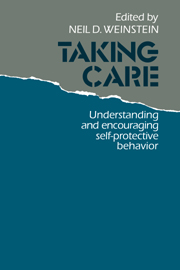Book contents
- Frontmatter
- Contents
- List of contributors
- Acknowledgments
- Introduction: studying self-protective behavior
- I Theoretical perspectives
- II Research and prevention programs for specific hazards
- 6 Why people take precautions against health risks
- 7 Community studies of smoking cessation
- 8 Preventing adolescent smoking
- 9 Natural hazards and precautionary behavior
- 10 Programs that encourage the adoption of precautions against natural hazards: review and evaluation
- 11 Why people take precautions against crime: a review of the literature on individual and collective responses to crime
- 12 Promoting citizen involvement in crime prevention and control
- 13 Injury prevention: limits to self-protective behavior
- 14 Perspectives on protective behaviors and work place hazards
- III Conclusion
- Index
6 - Why people take precautions against health risks
Published online by Cambridge University Press: 03 February 2010
- Frontmatter
- Contents
- List of contributors
- Acknowledgments
- Introduction: studying self-protective behavior
- I Theoretical perspectives
- II Research and prevention programs for specific hazards
- 6 Why people take precautions against health risks
- 7 Community studies of smoking cessation
- 8 Preventing adolescent smoking
- 9 Natural hazards and precautionary behavior
- 10 Programs that encourage the adoption of precautions against natural hazards: review and evaluation
- 11 Why people take precautions against crime: a review of the literature on individual and collective responses to crime
- 12 Promoting citizen involvement in crime prevention and control
- 13 Injury prevention: limits to self-protective behavior
- 14 Perspectives on protective behaviors and work place hazards
- III Conclusion
- Index
Summary
Introduction
The question Why do people take precautions against health risks? implicitly defines a domain of behaviors – behaviors that people deliberately engage in to protect themselves from what they perceive to be health risks. Several well-known models of illness behavior have been applied to preventive behavior. These models are based on the premise that people estimate the seriousness of risk or symptoms, evaluate the costs and benefits of action, and then choose a course of action that will maximize their expected outcome. If people have accurate information and carefully consider the advisability of alternative behaviors, these models may describe well the factors that influence behavior. However, most illness behaviors are more complex than the models imply. People sometimes act on the basis of behaviors learned in childhood or adolescence; evaluating the seriousness of a condition is usually difficult; people are not always aware of the factors that influence their behavior; and behaviors often serve multiple, non-health-related functions. Preventive health behavior is even more difficult to model because, in addition to the complexities listed above, the consequences of preventive behaviors are often delayed and probabilistic, and estimating the extent to which particular actions will reduce risk is difficult.
In this chapter I shall review several of the most widely cited theoretical models relevant to volitional preventive behaviors. These models have stimulated a tremendous amount of research, and the resultant data have provided important insights into health behavior.
- Type
- Chapter
- Information
- Taking CareUnderstanding and Encouraging Self-Protective Behavior, pp. 119 - 149Publisher: Cambridge University PressPrint publication year: 1987
- 24
- Cited by



